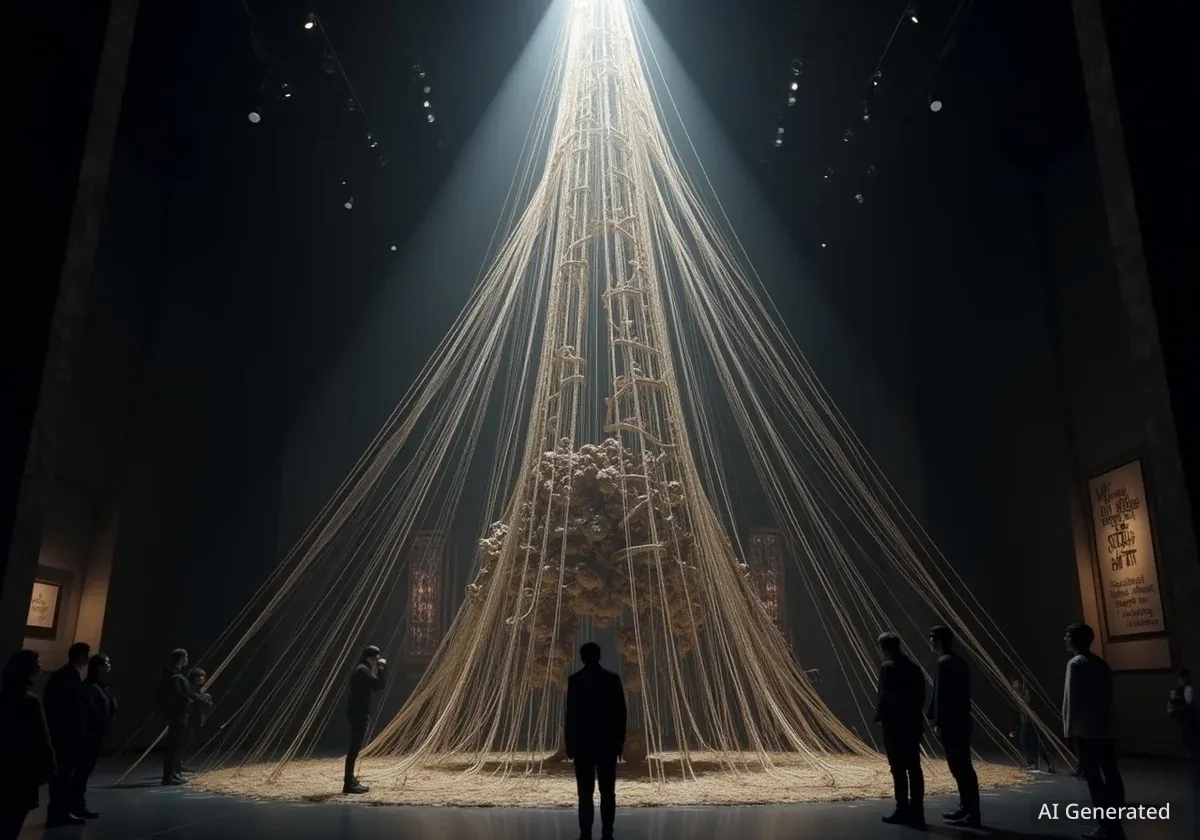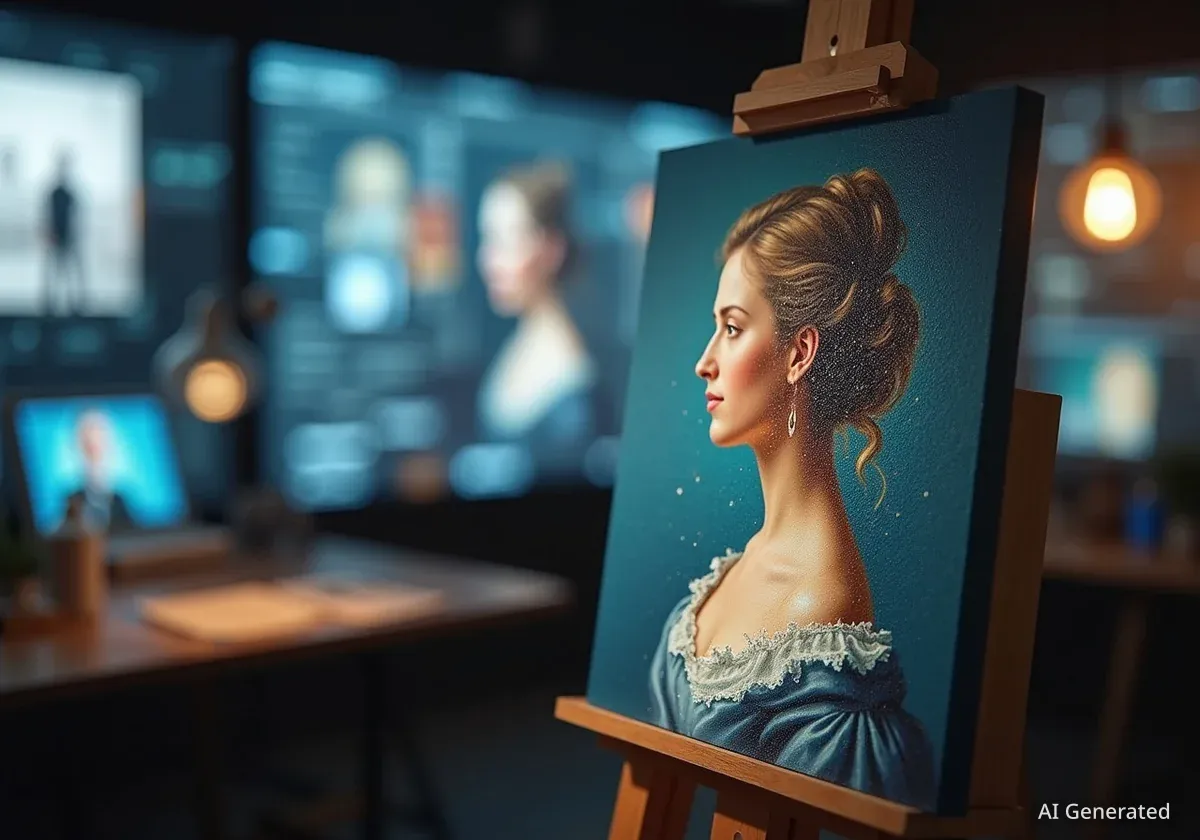Artist Conrad Shawcross has presented his most significant work to date, titled The Nervous System (Umbilical). This large-scale mechanical sculpture, currently on display at Here East in London, aims to explore profound concepts related to the nature of time and the universe. It represents the culmination of a decade-long project and is part of a series of seven "rope machines" developed over Shawcross's 25-year career.
The artwork invites viewers to observe a complex system of colored threads slowly intertwining and thickening into rope. This intricate process is designed to be both visually engaging and intellectually stimulating, challenging perceptions of reality and the cosmos.
Key Takeaways
- Conrad Shawcross's latest artwork, Umbilical, is a monumental rope machine.
- The sculpture explores the mysteries of time and the universe through mechanical art.
- It features 135 spools with varying arm lengths and gearing, designed to never repeat its pattern for billions of years.
- Umbilical is the most ambitious in a series of seven similar artworks by Shawcross.
- The piece will eventually reside permanently at the Museum of Old and New Art in Tasmania.
Exploring the Mechanics of Time and Reality
At the core of Shawcross's artistic practice lies an intersection of science and aesthetics. His works often blend mathematics, metaphysics, geometry, philosophy, mechanics, and myth. While visually striking, their deeper appeal comes from their intellectual depth.
Umbilical demonstrates this complexity. Viewers can sit on bean bags, looking up at the machine's intricate network of mechanical arms. Spools of colored threads, arranged in clusters, circulate slowly. These threads gradually unwind, twist, and braid, forming a thick rope that accumulates on the floor below.
The experience is designed to be immersive. According to Shawcross, this artwork, like his others, seeks to question our understanding of reality. He aims to represent concepts that are beyond immediate human perception.
Artwork Facts
- Title: The Nervous System (Umbilical)
- Height: 10 meters (approximately 33 feet)
- Number of Spools: 135
- Development Time: 10 years
- Current Location: Here East, Olympic Park, Stratford, East London
- Future Home: Museum of Old and New Art, Tasmania
The Artist's Vision: Beyond Perception
Conrad Shawcross describes his work as an attempt to make the unseen visible. He notes that as children, humans develop an understanding of the world, leading to an illusion of complete perception. "The thrill of science is that it challenges these constructed realities, makes us realise how illusionary it all is," Shawcross explains.
This perspective is central to all his creations, whether a massive machine or a small bronze sculpture. They all aim to represent ideas that humans may never fully grasp.
"There’s a really fine line," Shawcross says, "between having a hunch and madness and empirical research."
His intellectual background, with parents William Shawcross and Marina Warner being prominent writers, shaped his approach. He spent considerable time in lectures at the Ruskin School of Art and frequently visited science museums during his master's studies at the Slade, where he encountered figures like Charles Babbage and Ada Lovelace.
The Genesis of a Complex Machine
The concept for Umbilical emerged during a dinner conversation between Shawcross and David Walsh, founder of the Museum of Old and New Art (MONA) in Tasmania. Walsh, a mathematician who made his fortune through a gambling system, had initially planned to purchase one of Shawcross's earlier rope machines.
However, Shawcross proposed a more ambitious idea: a machine where all mechanical arms would have different lengths, all spools would be different sizes, and all gearing would lack a common denominator. This design would ensure the pattern of rope creation would never repeat.
Walsh accepted the challenge, leading to a "ten-year odyssey" for Shawcross. The project, which even Walsh initially believed impossible, required immense dedication and effort. Shawcross describes Walsh as a "Zeus looking down upon me, a mere mortal, as I struggled with his challenge."
Background on Rope Machines
Shawcross's "rope machines" series began with Yarn, first shown at the New Contemporaries exhibition in 2001. This early work brought him wider recognition. The series explores the concept of time through the physical process of rope formation. Each machine in the series represents a different aspect of this exploration, with Umbilical being the most complex.
Two other rope sculptures are also on display at Here East alongside Umbilical, providing context for the evolution of this artistic series.
Hands-On Creation and Team Effort
Shawcross is known for his hands-on approach to art. He prefers to be directly involved in the fabrication process, undertaking the "heavy lifting and working out the logistics." This commitment was crucial for Umbilical, a 10-meter-high structure.
He worked with a small team to build the entire sculpture, which includes 135 spools. The team even obtained scissor-lift licenses for assembly. Shawcross recalls transporting 45 trailer loads of materials with his family car to the Here East location, which is conveniently a short distance from his Clapton home and studio.
His wife, Carolina Mazzolari, also an artist working with weaving, and his two stepchildren and 11-year-old son live above his studio, highlighting the integrated nature of his life and work.
Time, Chaos, and the Universe
All of Shawcross's rope pieces delve into human perceptions of time. He conceptualizes the spools as planets, the point where ropes converge as the present, and the rope itself as the past. Umbilical advances this exploration by introducing a profound level of complexity and inherent chaos.
Unlike its predecessors, which operated with predictable patterns, Umbilical is designed to be non-repeating. Its initial alignment, a "zero point," ensures that no position will ever be exactly replicated. This means a viewer lying beneath the machine will never see the same pattern twice.
Mathematician Marcus de Sautoy, however, offered a scientific counterpoint, suggesting the machine would eventually repeat its pattern, but only after approximately 2.5 billion years. Shawcross humorously notes that by then, the sun would likely have consumed Earth.
Challenging Conventional Views of Time
Shawcross also examines the human tendency to find patterns where none exist, a concept known as apophenia. He argues that our descriptions of the universe are often apophenic.
- For over 3,000 years, humans have sought to understand the architecture of our solar system, looking for a grand design.
- We perceive our solar system, with its nine planets and 891 moons, as regular and repetitive.
- Our sense of time is defined by Earth's rotation around the sun.
- Calendars are based on the number 360 due to its mathematical neatness.
However, Shawcross points out that this desire for order often overlooks the "messy truth." The solar system was formed by catastrophic events. The sun is not static; it moves at immense speeds within a spiraling galaxy, which itself hurtles towards a black hole. Planets do not return to the exact same point after each rotation, reflecting an "innate chaos."
Cosmic Chaos
- The sun moves at unimaginable speeds within a spiral galaxy.
- Our galaxy also travels at incomprehensible speeds towards a black hole.
- Planets do not return to the exact same orbital position.
- The "innate chaos" of the universe is a core theme in Umbilical.
This chaos is what Umbilical aims to reflect. The machine continuously extrudes rope, its random patterns serving as a record of time's irregularities. Shawcross believes that artists who simply slow down or melt clocks do not truly address the core mystery of time.
His sculptures are not merely illustrative models. They possess a "poetic heart," exploring the profound mystery of time, a concept that remains elusive to both quantum physicists and children alike. He encourages visitors to experience Umbilical and ponder the passage of time.
Current and Upcoming Exhibitions
Umbilical is on display at Here East, London, until November 2. In addition to this major installation, Shawcross's work is also featured in a group exhibition titled Quantum Untangled. This show, opening today at Science Gallery London, delves into concepts such as false vacuum decay and steady-state theory.
These exhibitions provide multiple opportunities for the public to engage with Shawcross's unique blend of art, science, and philosophy. They offer a chance to consider the fundamental questions he poses about our universe and our place within it.




